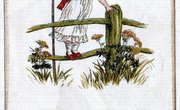First-graders encounter contractions in reading and use them when they speak, but fully understanding contractions takes practice. Interacting with contractions through a variety of activities shows first-graders how two words are combined with one word being shortened.
Contraction Match
First-graders might recognize "can't," but they might not realize it is made up of "can" and "not." A matching activity helps first-graders recognize the words that come together to create a contraction. Make pairs of cards: one with the contraction and one with the two words. The students match up the pairs. Another option is to write the contractions on a sheet of paper. Write the separate words on another sheet of paper. The students cut out the contractions and glue them next to the separate words.
Flip Books
A simple flip book provides first-graders with a way to review contractions. In a flip book, each page is slightly longer than the next so that about 2 inches of each page shows. On the visible section of each page, write a contraction that you want the first-graders to study. Lift each page and write the two separate words above each contraction. The separate words will be covered by the previous page when the book is closed. Students look at the visible contraction and think of the two words that make it. They flip up the page to see if they are correct.
Contraction Search
This first-grade language arts activity helps students focus on contractions in text. After reading a page with your reading groups or as a class, have the students go back to see if they spot any contractions. Write the contractions on the board. Discuss the two smaller words that make up the contraction. Rewrite the sentence on the board using the two separate words to see if it still makes sense. You can also have first-graders look through magazines to find examples of contractions that they can cut out.
Word Surgery
Students become word surgeons in this activity. The kids start with the two separate words printed on small pieces of paper. They cut out the letters that are removed to make the contraction. For example, to make "isn't," the kids would cut out the "o" from "not." They connect the leftover letters using tape or bandages to create "isn't." Make the activity entertaining for the kids by using disposable face masks like surgeons use.
Related Articles
Writer Bio
Based in the Midwest, Shelley Frost has been writing parenting and education articles since 2007. Her experience comes from teaching, tutoring and managing educational after school programs. Frost worked in insurance and software testing before becoming a writer. She holds a Bachelor of Arts in elementary education with a reading endorsement.











